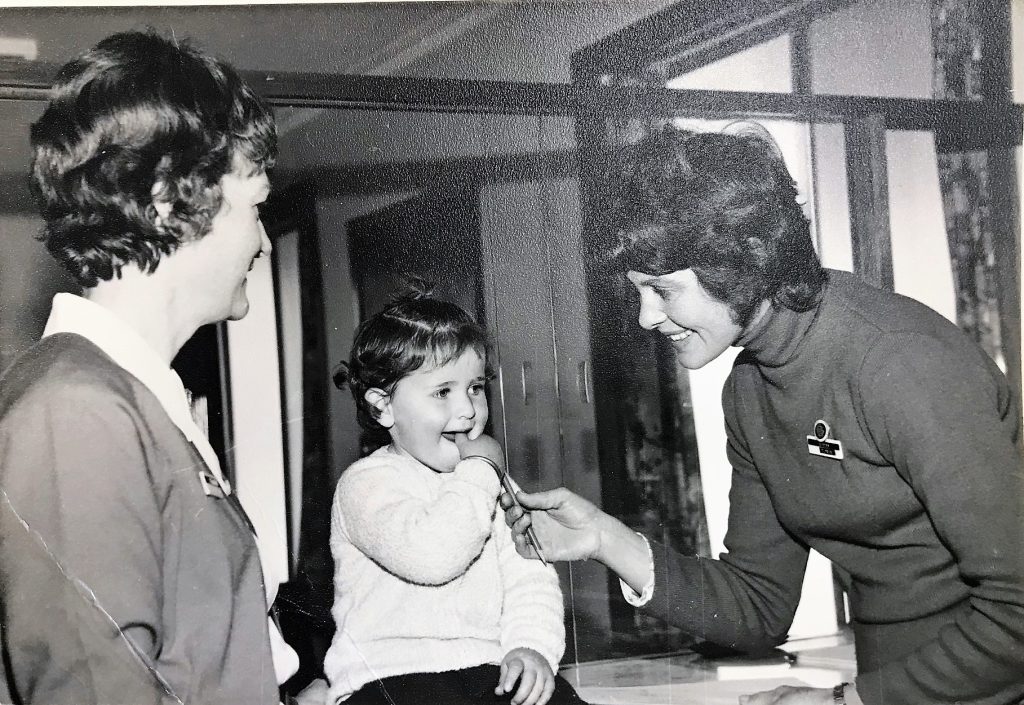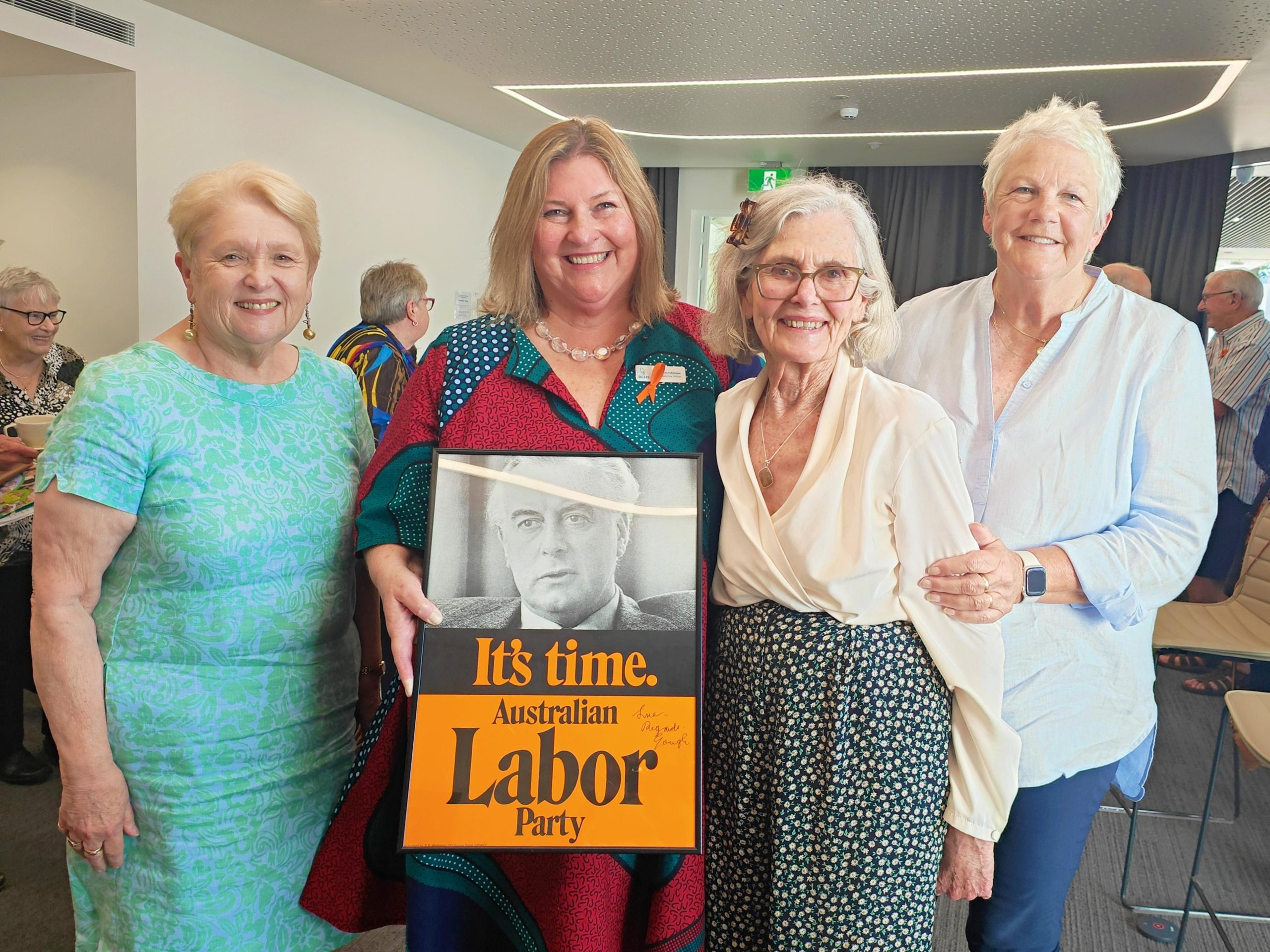How to encourage the 1970s man to have his annual influenza immunisation? A pot for a shot worked wonders at the Eaglehawk & Long Gully Community Health Centre. A free coldie at community health may not pass the pub test now, but there were plenty of other stories to learn from shared this week at the BCHS AGM.
To round off our 50th anniversary year, CEO Mandy Hutchinson invited three legends of the service back for a chat about all things Eaglehawk – the birthplace of BCHS.
Mandy was joined in the new community room by the service’s first nurse, Denise Main (pictured below in 1975), past nurse and later executive, Karen Riley, and former CEO Sue Clarke.

Bigger than a Borough flag
Karen was there from the nucleus of one of Australia’s first community health services – around the kitchen table with the Borough movers and shakers who made it all happen.
Karen’s father, Percy Shepperbottom, was on the committee that was handed the funds to kick start a service from then-PM Gough Whitlam in 1975.
Karen remembers the announcement being bigger than a two blues premiership win.
“Dad was very civic minded, and he had a great love of the Borough,” Karen said.
“There was no place like the Borough of Eaglehawk – Dad used to say you needed a passport to get across Jobs Gully Bridge to get in. There was a lot of significant committees and so forth – the council, the Dahlia and Arts committee, and the Community Health Board also seemed to be full of the most amazing people.
“There weren’t too many conversations around our dinner table at night that didn’t include what community health could look like at that point.
“I had no idea that that’s where I would end up. And in fact, my first experience of this building, and of community health, was as a patient, and that was in the very, very early days.
“To then go on and work here was amazing. It was exciting. Coming out here and working with Denise and her team, I learned so much.”
Writing the book on community health
Denise said with no blueprint for the community health nurse role in 1975, she began by going to straight to that amazing community.
“I drew on district nursing, I drew on veteran health nursing, on what was the Women’s Electoral Lobby at the time, which was investigating and promoting women and family health. So those helped me. Then the next thing was to forge these networks, find out and learn from people.”
Denise connected with the likes of schools, community organisations, and the Eaglehawk Benevolent Society, which was supporting mining widows and their families.
“And that gave me the sense of these are the people I need to learn from. These are the people that understand what the health needs are.”
Denise went on to help instigate many programs and services in response to those needs; for example, when tooth decay among Eaglehawk Primary School students was identified as a problem, community health introduced a school canteen of healthy foods and a dental program for the kids.
A motivation for agitating for the service was the unhealthy legacy of Eaglehawk’s mining past. The service started in a former house in Bright Street, then moved to a purpose-built centre in Seymoure Street, in what is still the site of BCHS – right over the top of the South Virginia Mine.
“When the architect and the engineers came to look at the site, they said, ‘it’s a mine shaft!’ And the committee said, this is where we want this community health centre. It has to be pram pushing distance for people,” Denise recalled. “That was one of Gough’s sayings.
“So I believe the architect, the engineers, all took themselves to Cornwell and they looked at the methods of capping and came back and here we are. We’re still over the mine.”

BYO morning tea and more
Karen said that new building quickly became central to people’s lives in Eaglehawk.
“If you walked through the waiting room, you would know a lot of people, but a lot of people knew each other,” she said.
“One of my fondest memories relates to an amazing GP we had called Dr Barbara Brooking. Everybody in Eaglehawk loved Barbara, including the staff, and including me. Now, people would come in, elderly people, young families, and so forth, they’d sit in the big waiting room up here. They’d have their morning tea with them. They’d have their crochet, their knitting or their favourite book, because they knew if they were Barbara’s patient, they’d wait and wait a long time.
“What did that tell me about our community and those patients, our people? They were loyal, they were humble, they were patient. And essentially, they felt part of a family within this building.
“I’ve not experienced that anywhere else. I think that in the early days it was probably easier for us to sort of have those sorts of relationships, but to see it still in action when I came back and worked with Sue and her team was just fabulous.”
Bridging a service for good
Even in 1999, when Sue Clarke arrived as CEO, she felt this was a special place.
While Sue had no history with Eaglehawk, she’d grown up in a country town, and recognised the same grounding ethos here.
“I just remember driving over that bridge and feeling like my childhood was returning in some ways, because I was truly in what felt like a community,” Sue said, adding she quickly learnt to work alongside them for the good of everyone.
“You’ve got some expertise perhaps, but the experts are the people in this room and in this community, and listening to them was pretty critical.”
Sue’s message to the BCHS of today was to “never lose sight of what matters most”, and that’s ensuring the community remains the driver of community health.
Time to pass on a treasure
When Gough Whitlam awarded those funds 50 years ago, he bypassed State Government and gave the money straight to the committee of Percy and co. Denise laughed it caused quite a stir at the time, but it also sent a message that the people called for community health, and they would best deliver it.
Sue spoke of the golden 90 minutes she spent with Whitlam on the occasion of community health’s 30th anniversary in 2005. She had travelled to Sydney with journalist Di Dempsey and former local MP David Kennedy – who was instrumental in campaigning for the local community health service.
During their meeting, where Gough was interviewed on his memories of the service’s establishment, he signed an original 1975 ‘It’s Time’ poster, ‘Sue – Regards Gough’.
During the panel chat, Sue gifted that precious piece of memorabilia to BCHS. There were more than a few teary-eyed staff in the room; a testament to the impact of the Whitlam Government’s social reforms still felt today.

